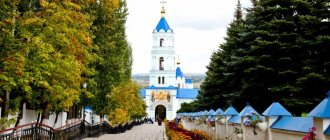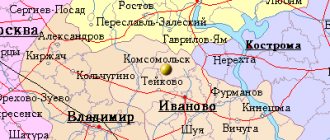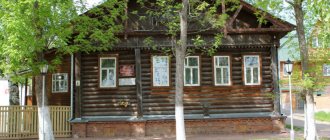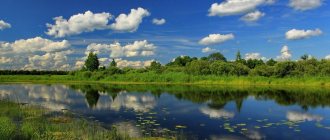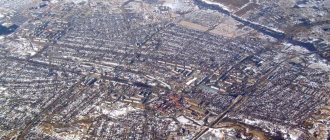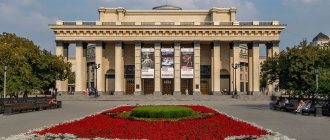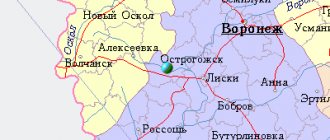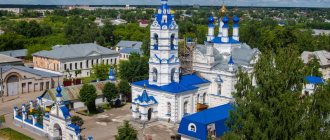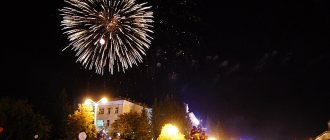Throughout our vast country, hundreds of springs gurgle quietly. Once upon a time, all of them, without exception, were potable without any conditions, and the water from them could be drunk without purification or boiling. In the Moscow region alone there are more than seven hundred active springs. Only a small fraction of the huge number was in satisfactory condition. Not long ago, the authorities became concerned about the fate of the springs, and large-scale work began on their improvement. Now the area near each has been cleared, information signs have been installed, and the location is indicated on an interactive map.
What is a spring
Springs are small streams that emerge from the depths of the earth. On their way to the surface, they pass through different layers of soil, and are considered unique bodies of water, although in fact there is nothing special about them. They emerge from the same horizons into which home wells go deep. Each spring has a different taste and chemical composition.
Small trickles of groundwater are one of the main sources of recharge for large surface bodies of water: lakes, ponds and rivers, and are an important part of the water balance in the environment. Their cradle is deep underground, in aquifers that are rarely polluted. Using the examination of spring water, it is possible to accurately determine the degree of contamination of underground horizons caused by the industrial and agricultural development of the region.
Nowadays, it is considered normal to increase the maximum permissible concentrations of nitrates, nitrites and pesticides during the period of spring snowmelt, when a huge amount of dirty water seeps from the fields. Closer to summer, the condition of the spring will normalize
Depending on the nature of the supply horizon: pressure or non-pressure, water comes out in two ways:
- A spring is a gravity stream that freely descends to the nearest surface body of water or goes underground again;
- The key is that the water comes out under pressure, sometimes as a low fountain.
In resort areas, waters with a specific chemical composition come to the surface, which is why they are called mineral springs. They are used as a treatment for various diseases. The opinion that all spring water has a miraculous effect on the body is half invented. Only an increased content of chemical compounds in the soil, and their natural transfer into underground water carriers, can help normalize the functioning of the cardiovascular system, cleanse the body of toxins and alleviate the course of chronic diseases.
In settlements with a favorable environmental situation, natural springs are actively used by local residents, summer residents and travelers who would not mind refreshing themselves with cool water. There is just one caveat for non-locals - an organism unaccustomed to the chemical composition can react violently with food poisoning and digestive system disorders. Sanitary services are not able to systematically check all active springs. But due to massive environmental pollution, they only allow the consumption of raw water from a few sources.
About the coat of arms and flag
REGULATIONS ON THE COAT OF ARMS OF THE municipal formation "Rodnikovsky Municipal District" of the Ivanovo Region This Regulation establishes the coat of arms of the municipal formation "Rodnikovsky Municipal District", its description and procedure for official use. 1. General Provisions
The coat of arms of the municipal formation "Rodnikovsky Municipal District" is compiled according to the rules and relevant traditions of heraldry and reflects historical, cultural, socio-economic, national and other local traditions.
The regulations on the coat of arms and drawings of the coat of arms of the municipal formation "Rodnikovsky Municipal District" in multi-color, one-color and single-color, using conventional shading to indicate color options are stored in the administration of the municipal formation "Rodnikovsky Municipal District" and are available for review to all interested parties.
2. Status of the coat of arms of the municipal formation “Rodnikovsky Municipal District”
2.1. The coat of arms of the municipal formation "Rodnikovsky Municipal District" is the official symbol of the municipal formation "Rodnikovsky Municipal District". 2.2. The coat of arms of the municipal formation "Rodnikovsky Municipal District" is subject to inclusion in the State Heraldic Register of the Russian Federation.
3. Heraldic description and rationale for the symbolism of the coat of arms of the municipal formation “Rodnikovsky Municipal District”
3.1. The heraldic description of the coat of arms of the municipal formation “Rodnikovsky Municipal District” reads: “In a field decorated with silver and azure (blue, light blue), there are two green leaves crosswise connected by cuttings with silver buds in green cups also connected, surrounded by a wavy, four-wave, cyclamora, changing from longitudinally through azure in silver to longitudinally through silver in azure .” 3.2. Description of the symbols of the municipal formation “Rodnikovsky Municipal District”. The coat of arms of the municipal formation “Rodnikovsky Municipal District” is uniform and harmonious in its content. Cyclamors (heraldic figures depicted as an irregular ellipse), or four waves (“springs”), symbolize the many springs flowing through the territory of the Rodnikovsky district and reservoirs, which gave the name to the center of the region - the city of Rodniki. Green leaves are a symbol of life, indicate the natural resources of the Rodnikovsky region and symbolize fertility, prosperity, and stability. Green color in heraldry symbolizes life, abundance, rebirth. The silver buds in the cups allegorically reflect the development in the area from the end of the 18th century. flax growing and textile production; the emergence of weaving and dyeing and finishing enterprises, on the basis of which later a large textile mill “Partnership of Manufactories A.M. Krasilitsikova and her sons" (now the leading enterprise of Rodniki-Textile JSC). Main industries: spinning, weaving, dyeing and finishing. Silver in heraldry is a symbol of simplicity, perfection, wisdom, nobility, peace, and mutual cooperation. 3.3. Author group: idea of the coat of arms:: Vladimir Gurov (Ivanovo), Konstantin Mochenov (Khimki); rationale for symbolism: Galina Tunik (Moscow); computer design: Yuri Korzhik (Voronezh).
4. The procedure for reproducing the coat of arms of the municipal formation “Rodnikovsky Municipal District”
4.1. Reproduction of the coat of arms of the municipal formation "Rodnikovsky Municipal District", regardless of its size and execution technique, must exactly correspond to the heraldic description given in Article 3 of these Regulations. Reproduction of the coat of arms of the municipal formation "Rodnikovsky Municipal District" is allowed in multi-color and single-color versions. The depiction of the coat of arms in a single-color version is allowed using conventional shading to indicate colors. Responsibility for distorting the design of the coat of arms, or changing the composition or colors that goes beyond the limits of the heraldic permissible, lies with the perpetrator of the distortions.
5. The procedure for the official use of the coat of arms of the municipal formation “Rodnikovsky Municipal District”
5.1. The coat of arms of the municipal formation "Rodnikovsky Municipal District" is placed: - on the facades of buildings of local governments, enterprises, institutions and organizations that are municipally owned;
- in the meeting rooms of local government bodies, work offices of elected officials of local government, heads of enterprises, institutions and organizations owned by municipal property;
- on the signs at the entrance to the territory of the municipal formation "Rodnikovsky Municipal District".
5.2. The coat of arms of the municipal formation "Rodnikovsky Municipal District" is placed on the letterheads of: - the Head of the municipal formation "Rodnikovsky Municipal District", the Head of the administration of the municipal formation "Rodnikovsky Municipal District", other elected officials of local government;
- representative and other local government bodies;
- heads of enterprises, institutions and organizations that are municipally owned;
- regulatory legal acts of local government bodies and local government officials;
- on official publications of local governments, enterprises, institutions and organizations owned by municipal property. 5.3. The coat of arms of the municipal formation "Rodnikovsky Municipal District" is reproduced on the certificates of persons serving in positions in local government bodies, municipal employees, deputies of the representative body of local government, members of other local government bodies, employees (employees) of enterprises, institutions and organizations located in the municipal property. The coat of arms of the municipal formation "Rodnikovsky Municipal District" is placed on the seals of local governments, enterprises, institutions and organizations that are municipally owned. 5.4. The coat of arms of the municipal formation "Rodnikovsky Municipal District" can be placed on:
- distinctive signs, awards of the Head of the municipal formation "Rodnikovsky Municipal District";
- distinctive signs, awards of a representative body of local government;
- on municipally owned vehicles.
It is allowed to place the coat of arms of the municipal formation "Rodnikovsky Municipal District" on: - publications of print media, local history publications of the municipal formation "Rodnikovsky Municipal District"; — letters, invitations, business cards of local government officials; as well as its use as a heraldic basis for the manufacture of signs, emblems, other symbols, design of city and other entertainment events. 5.5. The procedure for the production, use, storage and destruction of forms, seals and other media depicting the coat of arms of the municipal formation “Rodnikovsky Municipal District” is established by the local government bodies of the Rodnikovsky District. 6. The procedure for using the coat of arms of the municipal formation “Rodnikovsky Municipal District” by enterprises, institutions and organizations that are not municipally owned, as well as individuals. 6.1. The procedure for using the coat of arms of the municipal formation “Rodnikovsky Municipal District” by enterprises, institutions and organizations that are not municipally owned, as well as by individuals, is based on a contractual basis. 6.2. Other cases of using the coat of arms of the municipal formation “Rodnikovsky Municipal District” are established by legal acts of local government bodies and local government officials. 7. Liability for violation of these Regulations 7.1. The use of the coat of arms of the municipal formation "Rodnikovsky Municipal District" in violation of these Regulations, as well as desecration of the coat of arms of the municipal formation "Rodnikovsky Municipal District" entails liability in accordance with the legislation of the Russian Federation. 8. Final provisions
- The inclusion of any external decorations, as well as elements of official symbols of the Ivanovo region, into the composition (drawing) of the coat of arms of the municipal formation "Rodnikovsky Municipal District" is permissible only in accordance with the legislation of the Russian Federation and regulatory legal acts of the Ivanovo region. This change should be accompanied by a revision of Article 3 of these Regulations to reflect the changes made to the description.
- Control of compliance with the requirements of this Regulation on the coat of arms of the municipal formation "Rodnikovsky Municipal District" is entrusted to the administration of the municipal formation "Rodnikovsky Municipal District".
REGULATIONS ON THE FLAG of the municipal formation "Rodnikovsky Municipal District" of the Ivanovo Region This regulation establishes the flag of the municipal formation "Rodnikovsky Municipal District", its description and procedure for official use. 1. General Provisions
- The flag of the municipal formation "Rodnikovsky Municipal District" is compiled on the basis of the coat of arms of the municipal formation "Rodnikovsky Municipal District", according to the rules and corresponding traditions of heraldry, and reflects historical, cultural, socio-economic, national and other local traditions.
- The regulations on the flag and the original image of the flag of the municipal formation "Rodnikovsky Municipal District" are stored in the administration of the municipal formation "Rodnikovsky Municipal District" and are available for review to all interested parties.
2. Status of the flag of the municipal formation “Rodnikovsky Municipal District”
- The flag of the municipal formation "Rodnikovsky Municipal District" along with the coat of arms of the municipal formation "Rodnikovsky Municipal District" is the official symbol of the municipal formation "Rodnikovsky Municipal District".
- The flag of the municipal formation "Rodnikovsky Municipal District" is subject to inclusion in the State Heraldic Register of the Russian Federation.
3. Description and justification of the symbolism of the flag of the municipal formation “Rodnikovsky Municipal District”
3.1. Description of the flag of the municipal formation "Rodnikovsky Municipal District ": The flag of the municipal formation "Rodnikovsky Municipal District" is a rectangular panel with a width to length ratio of 2:3, quadruple divided in white and blue and reproducing in the center the figures from the coat of arms of the district in white, blue and green colors. 3.2. Justification of the symbolism of the flag of the municipal formation “Rodnikovsky Municipal District”. The flag of the municipal formation “Rodnikovsky Municipal District” is uniform and harmonious in its content. Cyclamors (heraldic figures depicted as an irregular ellipse), or four waves (“springs”), symbolize the many springs flowing through the territory of the Rodnikovsky district and reservoirs, which gave the name to the center of the region - the city of Rodniki. Green leaves are a symbol of life, point to the natural resources of the Rodnikovsky district and symbolize fertility, prosperity, and stability. Green color in heraldry symbolizes life, abundance, rebirth. The white buds in the cups allegorically reflect the development in the area since the end of the 18th century. flax growing and textile production; the emergence of weaving and dyeing and finishing enterprises, on the basis of which later a large textile mill “Partnership of Manufactories A.M. Krasilitsikova and her sons" (now the leading enterprise of Rodniki-Textile JSC). Main industries: spinning, weaving, dyeing and finishing. White color (silver) in heraldry is a symbol of simplicity, perfection, wisdom, nobility, peace, and mutual cooperation. 3.3. Author's group: idea of the flag: Vladimir Gurov (Ivanovo), Konstantin Mochenov (Khimki), rationale for the symbolism: Galina Tunik (Moscow), computer design: Yuri Korzhik (Voronezh). 4. The procedure for reproducing the flag of the municipal formation “Rodnikovsky Municipal District” 4.1. Reproduction of the flag of the municipal formation "Rodnikovsky Municipal District", regardless of its size and execution technique, must exactly correspond to the heraldic description given in paragraph 3.1. Article 3 of these Regulations. Responsibility for distortion of the design of the flag, or change in composition or colors that goes beyond the limits of what is heraldically unacceptable, lies with the performer of the distortion or change.
5. The procedure for the official use of the flag of the municipal formation “Rodnikovsky Municipal District”
5.1. The flag of the municipal formation “Rodnikovsky Municipal District” is raised constantly on the buildings of local governments, enterprises, institutions and organizations that are municipally owned; 5.2. The flag of the municipal formation "Rodnikovsky Municipal District" is permanently installed in the meeting rooms of local government bodies, the working offices of elected officials of local government, heads of enterprises, institutions and organizations owned by municipal property;
- The flag of the municipal formation "Rodnikovsky Municipal District" is placed on the vehicles of the Head of the municipal formation "Rodnikovsky Municipal District".
- The flag of the municipal formation "Rodnikovsky Municipal District" is raised (installed) during official ceremonies and other special events held by local governments.
5.5. The flag of the municipal formation “Rodnikovsky Municipal District” can be raised (installed) during ceremonial events held by public associations, enterprises, institutions and organizations, regardless of their form of ownership, as well as during family celebrations.
- As a sign of mourning, a black ribbon, the length of which is equal to the length of the flag, is attached to the upper part of the flagpole of the municipal formation “Rodnikovsky Municipal District”. As a sign of mourning, the flag of the municipal formation "Rodnikovsky Municipal District", raised on a mast or flagpole, must be lowered to half the height of the mast (flagpole).
- When raising (placing) the flags of the municipal formation “Rodnikovsky Municipal District” and the flag of the Ivanovo Region at the same time, the flag of the municipal formation “Rodnikovsky Municipal District” is located to the right of the flag of the Ivanovo Region (if you are facing the flags).
When raising (placing) the State Flag of the Russian Federation, the flag of the Ivanovo Region and the flag of the municipal formation “Rodnikovsky Municipal District” at the same time, the State Flag of the Russian Federation should be located in the center. To the left of it is the flag of the Ivanovo region, to the right is the flag of the municipal formation “Rodnikovsky Municipal District” (if you stand facing the flags). 5.8. When raising (placing) an odd number of flags (but more than three) at the same time, the State Flag of the Russian Federation is located in the center (if you stand facing the flags). When raising (placing) an even number of flags (but more than two) at the same time. The national flag of the Russian Federation is located to the left of center (if you stand facing the flags). To the right of the State Flag of the Russian Federation is the flag of the Ivanovo Region, to the left of the State Flag of the Russian Federation is the flag of the municipal formation “Rodnikovsky Municipal District”; To the right of the flag of the Ivanovo region is the flag of another municipal entity, public association, or enterprise, institution or organization.1 5.9. The size of the flag of the municipal formation "Rodnikovsky Municipal District" cannot exceed the size of the State Flag of the Russian Federation, the flag of the Ivanovo Region, the flag of another constituent entity of the Russian Federation, and the height of the flag of the municipal formation "Rodnikovsky Municipal District" cannot be greater than the height of the State Flag of the Russian Federation, the flag of the Ivanovo region, the flag of another constituent entity of the Russian Federation. 5.10. The image of the flag of the municipal formation "Rodnikovsky Municipal District" can be used as an element or heraldic basis on the distinctive signs, awards of the Head of the municipal formation "Rodnikovsky Municipal District", a representative body of local government;
1 The use of the State Flag of the Russian Federation by local government bodies and individuals is provided for in Art. 3 of the Constitutional Federal Law of the Russian Federation “On the State Flag of the Russian Federation” // “Rossiyskaya Gazeta” December 27, 2000 No. 344 (2608). 5.11. The design of the flag of the municipal formation "Rodnikovsky Municipal District" can be placed on the letterheads of: - The head of the municipal formation "Rodnikovsky Municipal District", other elected officials of local government;
- representative and other local government bodies;
- heads of enterprises, institutions and organizations that are municipally owned;
— regulatory legal acts of local government bodies and local government officials; — on official publications of local governments, enterprises, institutions and organizations owned by municipal property;
- on the certificates of the head of the city, persons serving in positions in local government bodies, municipal employees, deputies of the representative body of local government; members of other local government bodies; employees (workers) of enterprises, institutions and organizations that are municipally owned;
- distinctive signs, awards of the head of the municipal formation “Rodnikovsky District”;
- distinctive signs, awards of a representative body of local government;
- on municipally owned vehicles. 5.12. It is allowed to place the flag of the municipal formation "Rodnikovsky Municipal District" on: - publications of print media, local history publications of the municipal formation "Rodnikovsky Municipal District"; - letters, invitations, business cards of local government officials, as well as its use as a heraldic basis for the manufacture of signs, emblems, other symbols, design of city and other entertainment events. 5.13. The procedure for the production, use, storage and destruction of forms, seals and other carriers of the image of the flag of the municipal formation "Rodnikovsky Municipal District" is established by the local government bodies of the municipal formation "Rodnikovsky Municipal District".
6. The procedure for using the flag of the municipal formation “Rodnikovsky Municipal District” by enterprises, institutions and organizations that are not municipally owned
6.1. The procedure for using the flag of the municipal formation “Rodnikovsky Municipal District” by enterprises, institutions and organizations that are not municipally owned is based on a contractual basis. 6.2. Other cases of use of the flag of the municipal formation “Rodnikovsky Municipal District” are established by legal acts of local government bodies and local government officials.
7. Liability for violation of this Regulation
7.1. The use of the flag of the municipal formation "Rodnikovsky Municipal District" in violation of these Regulations, as well as desecration of the flag of the municipal formation "Rodnikovsky Municipal District" entails liability in accordance with the legislation of the Russian Federation.
8. Final provisions
8.1. Introducing any changes or additions to the composition (drawing) of the flag of the municipal formation "Rodnikovsky Municipal District", as well as elements of the official symbols of the Ivanovo region, is permissible only in accordance with the legislation of the Russian Federation and regulatory legal acts of the Ivanovo region. These changes must be accompanied by a revision of Article 3 of these Regulations to reflect the new elements in the description. 8.2. The right to use the flag of the municipal formation "Rodnikovsky Municipal District" belongs to the local government bodies of the municipal formation "Rodnikovsky Municipal District".
- The flag of the municipal formation "Rodnikovsky Municipal District" since its approval by the representative body of the municipal formation "Rodnikovsky Municipal District" in accordance with the Law of the Russian Federation of July 9, 1993. No. 5351-1 “On copyright and related rights” is not protected by copyright.
- Control of compliance with the requirements of these Regulations is assigned to the administration of the municipal formation “Rodnikovsky Municipal District”.
- This Regulation comes into force on the date of its official publication.
How to properly collect and store spring water
Having seen and tasted something good, we definitely want to take at least a small part of it with us. The situation is the same with spring water - large queues with bottles and canisters line up at the most famous springs with a proven healing effect.
If the collected spring water at home begins to become cloudy, green, or a specific “smell” appears, this means that organic matter has begun to actively develop in it. Microscopic algae and colonies of microorganisms grow in a “living” environment
Plastic containers are the most unsuitable container for drinking water in general, even bottled water, and even more so for healing spring water. The best option is glass containers that do not react with water when exposed to sunlight or elevated temperatures.
Typically, the outlet of a spring is formed by a pipe or groove through which water flows. You need to fill the container directly from it, and not scoop it up from a pool in the ground.
Spring water is not a product that you can stock up on for future use. The maximum storage period is 3-4 days. Then natural chemical and organic processes begin, which worsen its organoleptic characteristics and make it unsuitable for consumption. Due to colloidal impurities, water can form sediment on the walls of the dishes. You should not collect water if a dark coating is visible at the bottom of the spring reservoir.
Water supply from a spring
In addition to the standard water intake directly into containers from a source with a sufficient flow rate, it is possible to organize water supply for the entire site. Of course, you will have to work on clearing and arranging the territory, but it will be worth it. The idea of a spring water supply is especially relevant for temporary water supply until a well or borehole is dug and water is already needed.
Pure spring water does not require additional treatment with filters and water treatment systems that change its natural structure and chemical composition.
The disadvantage of a spring as a point of main water intake for household needs is its low return. On average, a trickle fills a 5-liter jar in a couple of minutes, but there are keys with a weaker output. It is clear that it will not be possible to directly power private water supplies from them. For such cases, a method for capturing springs has been developed. Near the source, a capture chamber is dug and lined, which will accumulate a reserve of water, and from it the supply to the water intake points is organized.
The presence of springs and rivers in the vicinity of the estate is a sure sign of the promising location of aquifers in the ground. It is considered especially lucky if, when digging a home well, it was possible to open underground springs and fontanelles, then there will always be water in the well and with a good influx
The use of springs of public importance for personal farming is possible only if the rights of other residents of the locality in which the spring is located are not infringed. Alternatively, you can arrange for excess water to be supplied from the outlet point so that no one feels left out.
The disadvantage of such a structure is that the owner of the site will not be able to monitor and protect the spring around the clock, unlike a home well, to which access to unauthorized persons is prohibited.
Official tourism portal of the Ivanovo region
The first mention of Rodniki as a village was preserved in the list of possessions of the Suzdal Women's Intercession Monastery for 1606. The name of the village comes from water-bearing springs (fontanelles), one of which still exists today.
By the end of the 17th century, Rodniki became a small village with a wooden St. Elias Church built. In 1764, the village of Rodniki was included in the Dunilov economy of the Lukh volost of the Suzdal province. Since the end of the 18th century, Rodniki has been part of the Yuryevets district of the Kostroma province.
Since the second half of the 18th century. Residents of the village of Rodniki were engaged in textile crafts in their free time from agricultural work. The raw material for this was flax, the crops of which expanded year by year. Rodnikov workers specialized in the production of narrow canvases, and from the beginning of the 19th century. In the Rodnikovsky district, smooth fabric dyeing became widespread. Over the years, the number of dyers grew, and they even had to divide their area into service areas.
The most enterprising dyer in Rodniki was the state peasant Grigory Mikhailov, who paid dues to the Dunilov economy. The year of Gregory’s death (1820) went down in the history of Rodniki as the year the textile enterprise was founded, which over time became one of the best in Russia. Gregory's heirs took the matter on a much larger scale. A. M. Krasilshchikova was especially successful in this. In 1894, under her auspices, the Partnership of Manufactories “Anna Krasilshchikova and her Sons” was formed. Thus, a large textile enterprise with ten thousand workers, with auxiliary factories, a railway line and steamships on the Volga, with shopping malls in Moscow, Nizhny Novgorod, Kharkov, Siberia and Turkey grew up in Rodniki.
After the death of Anna Mikhailovna Krasilshchikova in 1902, her sons Fedor, Peter and Nikolai owned the Rodnikov factories. The most famous of them was the youngest, Nikolai Mikhailovich, a hereditary Honorary Citizen of Russia. In May 1913, at a dinner party in Kostroma in honor of the 300th anniversary of the House of Romanov, N.M. Krasilshchikov sat next to Emperor Nikolai P. By the way, Nikolai Mikhailovich and his wife Elizaveta Alekseevna were the last owners of the enterprise. Currently, the descendants of the Krasilshchikov factory owners live in Moscow and abroad - in Italy and France. Thus, in Moscow, the director of the scientific and memorial museum N.E. Zhukovsky is Doctor of Technical Sciences, professor, laureate of the USSR State Prize Alexander Petrovich Krasilshchikov.
The Krasilshchikov factory owners launched large-scale cultural, educational and charitable activities in Rodniki, paying special attention to the spiritual and moral education of the local population. So, in 1887, a new stone church was built on the site of the old wooden Elias Church. Her project is based on a copy of one of the Byzantine cathedrals. With the Krasilshchikovs' funds, the People's House, a factory hospital, a public meeting building, a factory school for workers, and schools for children in the surrounding villages were built in Rodniki.
At the beginning of the 20th century, the revolutionary and social democratic movement intensified in Rodniki. The organizer of the Social Democratic group in the Rodnikovsky factory district was I.V. Lyubimov, who later became a major party and government figure in the country. One of the leaders of the Rodnikov group of the RSDLP was K.V. Ukhanov - later Chairman of the Moscow City Council, Deputy People's Commissar of Supply of the USSR, People's Commissar of Local and Light Industry of the RSFSR. At the end of the 30s I.E. Lyubimov and K.V. The Wukhanovs became victims of unjustified political repression. Rodnikovsky worker social democrats A.V. Kalinin, P.I. Surkov, N.R. Shagov were elected deputies of the 2nd, 3rd and 4th State Dumas.
Famous people in Rodniki at the beginning of the 20th century were engineers N.B. Rozhkov, P.Kh. Mathisen, K.I. Nastyukov, A.O. Gorev (cadet, deputy of the Third State Duma), A.A. Borneman, chief accountant A.V. Ponomarev, doctor D.A. Bulashevich, teacher V.A. Khalezov, artist-architect L.R. Sologub. The regent of the choir of singers in the Rodnikovsky Elias Church was V.I. Kastorsky, who later became a soloist of the St. Petersburg Opera Mariinsky Theater.
The events of October 1917 did not spare the Rodnikovsky region. In 1918, all textile enterprises owned by the Krasilshchikov factory owners were nationalized in Rodniki. After nationalization, the Rodnikov textile enterprise received the name BOLSHEVIK plant. Also in 1918, the village of Rodniki received city status. The city of Rodniki became the center of the region that arose on part of the territory of the former Yuryevets, Kineshma, Nerekhta and Shui districts. From 1918 to 1921 At the Bolshevik plant, the nationally famous commissar of the cruiser Aurora, A.V., worked in the repair shops. Belyshev.
In the turbulent and controversial 30s, Rodnikovsky textile workers Tatyana Ivanovna Odintsova and Irina Alekseevna Lapshina were the initiators of the multi-machine movement.
During the Great Patriotic War, 8 natives of Rodnikovskaya land were awarded the high title of Hero of the Soviet Union: V. I. Borisov, V. S. Volkov, Yu. P. Kurguzov, M. A. Mazurin, P. A. Milov, A. V. Ryzhikov, P. I. Sakharov, M. I. Shilov.
A major organizer of the country's defense industry, First Deputy People's Commissar of Armaments of the USSR, Colonel General V. M. Ryabikov, awarded the title of Hero of Socialist Labor, began his career as a worker at the Rodnikovsky Bolshevik plant.
Since the mid-60s, significant construction began in the city. A factory for the production of corduroy cord and a new central boiler house were built at the plant, and housing construction expanded. In 1970, in connection with the 150th anniversary, the plant was awarded the Order of the Red Banner of Labor. Rodnikovsky melange plant "Bolshevik" since 1993 - JSC "Rodniki - Textile". Rodnikovsky melange fabrics go to almost all regions of Russia and are exported to Germany, Italy, and Spain.
City governments pay great attention to education and healthcare. In Rodniki there are 4 secondary, 3 incomplete secondary, 1 correctional school, vocational school, branches of the Ivanovo Textile College and the Ivanovo Textile Academy. There are 12 preschool institutions and an orphanage in the city.
The pride of Rodnikov residents was the park-arboretum (botanical garden) created at the anti-tuberculosis dispensary, where there are more than 330 species of trees and shrubs and more than 200 varieties of medicinal plants brought to Rodniki from many regions of our country and from abroad. The founder of the Botanical Garden is Doctor of Medical Sciences A. A. Saleev, elected Honorary Member of the All-Russian Society for Environmental Protection. Seedlings of valuable species grown in the botanical garden decorate many gardens and parks in Russia.
And finally, it is impossible not to note the fact that in 1998 the first public library in Russia was opened in Rodniki.
Legal aspects of using springs
From the point of view of the law, a natural spring is a body of water. Ownership and other rights are described in detail in several articles. According to them, an individual or legal entity can own and manage only isolated reservoirs of artificial origin with a standardized area.
They must be non-flowing and not communicate with any surface water bodies. Simply put, if you dug a pond on your property and filled it from a tap, borehole or well, it is completely yours, and all other objects are the property of the Russian Federation or its constituent entities.
You cannot take possession of the spring, but it can be taken on a short-term or long-term lease if its purposes do not adversely affect the environment and are consistent with the power of the source.
Theoretically, a non-separated public spring can only be rented, for example, for the production of drinking water. Although the authorities should not agree to such agreements due to the fact that ordinary users will lose the opportunity to use water.


